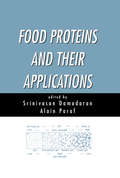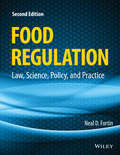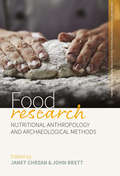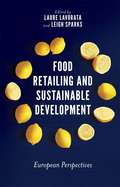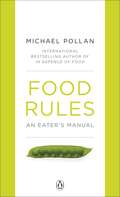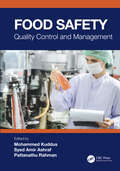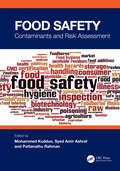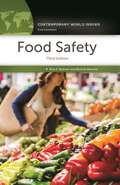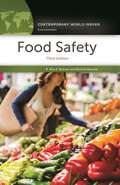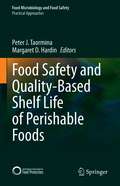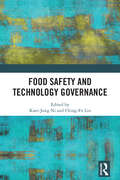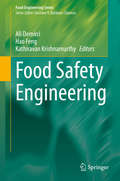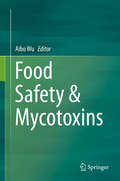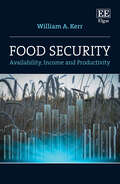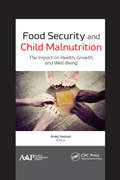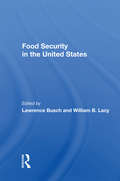- Table View
- List View
Food Proteins and Their Applications
by Srinivasan DamodaranReviews the physiochemical properties of the main food proteins and explores the interdependency between the structure-function relationship of specific protein classes and the processing technologies applied to given foods. The book offers solutions to current problems related to the complexity of food composition, preparation and storage, and includes such topics as foams, emulsions, gelation by macromolecules, hydrolysis, microparticles/fat replacers, protein-based edible films, and extraction procedures.
Food Proteins and Their Applications (Food Science And Technology Ser. #80)
by Srinivasan DamodaranReviews the physiochemical properties of the main food proteins and explores the interdependency between the structure-function relationship of specific protein classes and the processing technologies applied to given foods. The book offers solutions to current problems related to the complexity of food composition, preparation and storage, and includes such topics as foams, emulsions, gelation by macromolecules, hydrolysis, microparticles/fat replacers, protein-based edible films, and extraction procedures.
Food Regulation: Law, Science, Policy, and Practice
by Neal D. FortinFeaturing case studies and discussion questions, this textbook – with revisions addressing significant changes to US food law – offers accessible coverage appropriate to a wide audience of students and professionals. Overviews the federal statutes, regulations, and regulatory agencies concerned with food regulation and introduces students to the case law and statutory scheme of food regulation Focuses updated content on the 2011 FDA Food Safety Modernization Act (FSMA), the biggest change to US food law since the 1930s Contains over 20% new material, particularly a rewritten import law chapter and revisions related to food safety regulation, health claims, and food defense Features case studies and discussion questions about application of law, policy questions, and emerging issues
Food Regulation: Law, Science, Policy, and Practice
by Neal D. FortinFeaturing case studies and discussion questions, this textbook – with revisions addressing significant changes to US food law – offers accessible coverage appropriate to a wide audience of students and professionals. Overviews the federal statutes, regulations, and regulatory agencies concerned with food regulation and introduces students to the case law and statutory scheme of food regulation Focuses updated content on the 2011 FDA Food Safety Modernization Act (FSMA), the biggest change to US food law since the 1930s Contains over 20% new material, particularly a rewritten import law chapter and revisions related to food safety regulation, health claims, and food defense Features case studies and discussion questions about application of law, policy questions, and emerging issues
Food Research: Nutritional Anthropology and Archaeological Methods (Research Methods for Anthropological Studies of Food and Nutrition #1)
by Janet Chrzan and John BrettBiocultural and archaeological research on food, past and present, often relies on very specific, precise, methods for data collection and analysis. These are presented here in a broad-based review. Individual chapters provide opportunities to think through the adoption of methods by reviewing the history of their use along with a discussion of research conducted using those methods. A case study from the author's own work is included in each chapter to illustrate why the methods were adopted in that particular case along with abundant additional resources to further develop and explore those methods.
Food Retailing And Sustainable Development: European Perspectives (PDF)
by Laure Lavorata Leigh SparksFaced with dwindling resources and the challenge of climate change, companies are seeking to enhance production while consuming fewer resources. At the same time, consumers are altering their behaviors by seeking local production or bulk buying products. Retailers, as boundary spanners between consumers and producers, have a major role in initiating change and sustainable development. Part one of this book analyzes the sustainable development practices of retailers within and between different European countries and presents case studies that consider best practices on this topic. Retailer include: Carrefour, Casino, Auchan, Leclerc, Intermarché and System U in France; Inditex, Cortefiel and MANGO in Spain; Edeka, Rewe, Schwarz-Group (with Lidl and Kaufland) and Aldi in Germany; and Tesco and Marks & Spencer in UK. International retailers in Poland are considered to better understand cross country activities. Part two underlines the challenges faced by European retailers in the wake of societal and technological changes. The consumers' role and their sustainable development practices are analyzed to understand the impact on retailing and the main risks for retailers. This book will appeal to academics, students and professional educators alike, providing a crucial understanding of retailers' practices in different countries and their impact on consumers.
Food Retailing And Sustainable Development: European Perspectives
by Leigh Sparks Laure LavorataFaced with dwindling resources and the challenge of climate change, companies are seeking to enhance production while consuming fewer resources. At the same time, consumers are altering their behaviors by seeking local production or bulk buying products. Retailers, as boundary spanners between consumers and producers, have a major role in initiating change and sustainable development. Part one of this book analyzes the sustainable development practices of retailers within and between different European countries and presents case studies that consider best practices on this topic. Retailer include: Carrefour, Casino, Auchan, Leclerc, Intermarché and System U in France; Inditex, Cortefiel and MANGO in Spain; Edeka, Rewe, Schwarz-Group (with Lidl and Kaufland) and Aldi in Germany; and Tesco and Marks & Spencer in UK. International retailers in Poland are considered to better understand cross country activities. Part two underlines the challenges faced by European retailers in the wake of societal and technological changes. The consumers' role and their sustainable development practices are analyzed to understand the impact on retailing and the main risks for retailers. This book will appeal to academics, students and professional educators alike, providing a crucial understanding of retailers' practices in different countries and their impact on consumers.
Food Rules: An Eater's Manual
by Michael PollanEat food. Mostly plants. Not too much. Using those seven words as his guide, Michael Pollan offers this indispensable handbook for anyone concerned about health and food. Simple, sensible and easy to use, Food Rules is a set of memorable adages or 'personal policies' for eating wisely, gathered from a wide variety of sources: mothers, grandmothers, nutritionists, anthropologists and ancient cultures among them. Whether at the supermarket, a restaurant or an all-you-can-eat buffet, this handy, pocket-size resource is the perfect manual for anyone who would like to become more mindful of the food we eat. For the past twenty years, Michael Pollan has been writing about the places where the human and natural worlds intersect: food, agriculture, gardens, drugs, and architecture. The Omnivore's Dilemma, about the ethics and ecology of eating, was named one of the ten best books of 2006 by the New York Times and the Washington Post. He is also the author of The Botany of Desire, A Place of My Own and Second Nature and, most recently, In Defence of Food.
Food Safety: Quality Control and Management
by Mohammed Kuddus Syed Amir Ashraf Pattanathu RahmanThis book is an updated reference source on food safety best practices. The chapters discuss analytical approaches to measuring food contaminants, quality control and risk assessment of food storage, food irradiation, etc. The contributors discuss how quality control and management help to establish sustainable and secure food systems globally. The book covers topics such as techniques to measure food contaminants, toxins, heavy metals and pesticide content in food.FEATURES Examines the role of food safety approaches in global food supply chains Describes various detection techniques for food contaminants and toxins Discusses the application of nanotechnology and other innovations in food safety and risk assessment Reviews the international regulations for management of food hazards Includes the hazard analysis critical control points (HACCP) principles This book is an essential resource to help students, researchers, and industry professionals understand and address day-to-day problems regarding food contamination and safety and their impact on human health.
Food Safety: Quality Control and Management
by Mohammed Kuddus Syed Amir Ashraf Pattanathu RahmanThis book is an updated reference source on food safety best practices. The chapters discuss analytical approaches to measuring food contaminants, quality control and risk assessment of food storage, food irradiation, etc. The contributors discuss how quality control and management help to establish sustainable and secure food systems globally. The book covers topics such as techniques to measure food contaminants, toxins, heavy metals and pesticide content in food.FEATURES Examines the role of food safety approaches in global food supply chains Describes various detection techniques for food contaminants and toxins Discusses the application of nanotechnology and other innovations in food safety and risk assessment Reviews the international regulations for management of food hazards Includes the hazard analysis critical control points (HACCP) principles This book is an essential resource to help students, researchers, and industry professionals understand and address day-to-day problems regarding food contamination and safety and their impact on human health.
Food Safety: Contaminants and Risk Assessment
by Mohammed Kuddus Syed Amir Ashraf Pattanathu RahmanFood Safety: Contaminants and Risk Assessment is a state-of-art reference on food safety, which is the biggest challenge in the food supply chains worldwide. Despite advancements in hygiene, food treatment, and food processing, foodborne pathogens or food contaminants still represent a significant threat to human health. This book presents comprehensive information about the major food contaminants across food types. The text provides facts about setting up food safety initiatives and safety rules, foodborne pathogen detection, production and processing compliance issues, and safety education.Key Features Examines a diverse range of contaminants across food types Describes various food allergens and allergies Discusses contamination in drinking water and bottled water Reviews the international regulations for management of food hazards Throws light on the overall impact of food safety of global food supply chains This book is meant for postgraduate students, researchers, and food industry professionals.
Food Safety: A Reference Handbook (Contemporary World Issues)
by Nina E. Redman Michele MorronePresenting compelling and current information about some of the most important food safety issues, this book is an invaluable reference for anyone interested in avoiding foodborne disease or understanding how food safety standards could be improved.Food safety affects everyone. For citizens who live in industrialized nations, it is easy to assume that our foods are always rigorously inspected and assessed for safety. While food safety standards and regulations are in place to protect the consumer public, food safety problems do exist: according to the Centers for Disease Control and Prevention, each year, 48 million Americans are sickened by food,128,000 people are sick enough that they are hospitalized as a result, and 3,000 people die from foodborne pathogens.This third edition of Food Safety: A Reference Handbook examines the history of food safety and describes in detail key events and trends that have created the food safety issues of today. It explores the many controversies concerning food consumption, including contaminants in food, GMOs, factory farm-produced meat, and standards regarding the labeling of food products as well as the ways that these issues have been handled by authorities. Readers will find this book's overview of food safety topics informative and highly accessible. Additionally, the perspectives chapter provides varying viewpoints from food safety professionals and researchers on key issues.
Food Safety: A Reference Handbook (Contemporary World Issues)
by Nina E. Redman Michele MorronePresenting compelling and current information about some of the most important food safety issues, this book is an invaluable reference for anyone interested in avoiding foodborne disease or understanding how food safety standards could be improved.Food safety affects everyone. For citizens who live in industrialized nations, it is easy to assume that our foods are always rigorously inspected and assessed for safety. While food safety standards and regulations are in place to protect the consumer public, food safety problems do exist: according to the Centers for Disease Control and Prevention, each year, 48 million Americans are sickened by food,128,000 people are sick enough that they are hospitalized as a result, and 3,000 people die from foodborne pathogens.This third edition of Food Safety: A Reference Handbook examines the history of food safety and describes in detail key events and trends that have created the food safety issues of today. It explores the many controversies concerning food consumption, including contaminants in food, GMOs, factory farm-produced meat, and standards regarding the labeling of food products as well as the ways that these issues have been handled by authorities. Readers will find this book's overview of food safety topics informative and highly accessible. Additionally, the perspectives chapter provides varying viewpoints from food safety professionals and researchers on key issues.
Food Safety: Contaminants and Risk Assessment
Food Safety: Contaminants and Risk Assessment is a state-of-art reference on food safety, which is the biggest challenge in the food supply chains worldwide. Despite advancements in hygiene, food treatment, and food processing, foodborne pathogens or food contaminants still represent a significant threat to human health. This book presents comprehensive information about the major food contaminants across food types. The text provides facts about setting up food safety initiatives and safety rules, foodborne pathogen detection, production and processing compliance issues, and safety education.Key Features Examines a diverse range of contaminants across food types Describes various food allergens and allergies Discusses contamination in drinking water and bottled water Reviews the international regulations for management of food hazards Throws light on the overall impact of food safety of global food supply chains This book is meant for postgraduate students, researchers, and food industry professionals.
Food Safety and Quality-Based Shelf Life of Perishable Foods (Food Microbiology and Food Safety)
by Peter J. Taormina Margaret D. HardinThis book addresses the shelf life of foods, a key factor in determining how food is distributed and consequently where and when different food products are available for consumption. Shelf life is determined by several factors, including microbiological, chemical, physical, and organoleptic deterioration. Often these factors are interrelated and interdependent. The editors of this volume focus specifically on the microbial factors related to shelf life of perishable foods and food commodities. This allows for more detailed coverage of foodborne bacterial pathogens and spoilage microorganisms of concern. The initial part of the book covers the why and how of shelf life determination as well as the specific microbial pathogens and spoilage microorganisms of concern for perishable foods. Contributors address topics such as the techniques utilized for determination of shelf life, the frequency of shelf life testing for different products, the interpretation of data to make shelf life determinations, and management of shelf life of food products from the perspective of the food producer, distributor, retailer, and regulator. Three key areas impacting shelf life are addressed in detail: sanitation, processing, and packaging. The sanitation chapter explains the necessary components of cleaning and sanitizing to assure a hygienic processing environment and why that is critical to shelf life control. Traditional processing procedures are reviewed and advanced processing technologies are explored. Materials used in food packaging and the utilization of traditional and activated food packaging by product type are covered in detail. The latter two chapters of the book delve into newer techniques of analysis and explore the microbiome of food products. Implications of microbial ecology and microbial quantification in food products are discussed in chapters on genomics and in the changing dogma of meat shelf life. The primary audience for this work includes food industry quality and food safety technicians, managers, directors, and executives responsible for shelf life. Academicians and governmental researchers involved in research and teaching about food safety and quality will also find the material relevant and useful.
Food Safety and Quality in the Global South
by Sylvester Chibueze Izah Matthew Chidozie Ogwu Nontuthuko Rosemary NtuliThis book focuses on sustainable food systems in the Global South as highlighted by the United Nations Sustainable Development Goal 2, which seeks to end global hunger through food and nutrient security. It addresses the organoleptic properties of food that contribute to food quality as well as aspects of food safety such as the systematic handling, preparation, packaging, contamination, and storage within the food system to ensure food quality is maintained while preventing food-borne illnesses. The book assesses the state of food quality in the Global South and promotes the establishment of critical control points for food quality monitoring and maintaining adequate nutrient levels in food while keeping out organic, inorganic, and synthetic contaminants. The book also contains recommendations for corrective actions, including consumer information systems and remedial health actions. The book systematically connects food safety and quality in the Global South with broader health and sustainable development implications, including the rising concern of non-communicable diseases. This comprehensive book delves into various aspects of food safety and quality in the Global South, offering insights into challenges, solutions, and emerging trends across multiple disciplines. This book serves as a valuable resource for academics, researchers, policymakers, and practitioners involved in food science, public health, and sustainable development. The diverse range of topics covered contributes to a holistic understanding of the complexities involved in ensuring safe and high-quality food in the unique context of the Global South.
Food Safety and Technology Governance
by Ching-Fu Lin Kuei-Jung NiRecent advances in agri-food technology have brought about increasing complexity and emerging challenges to food safety regulation and governance, with many countries greatly divided in their regulatory approaches. As more advanced CRISPR based gene-editing technologies, and novel foods such as cloned animal products, non-traditional plants, nanofood, and plant-based meat are rapidly being developed, debates arise as to whether the existing models of governance require revision to ensure consumer safety. Of equal importance is the extensive use of pesticides, additives, and animal drugs which raise concerns over the methods and approaches of government approval and phasing out of potentially risk-causing chemicals. Heightened public criticism of food safety and technology poses a significant challenge to governments around the world, which struggle to strike a proper balance between technocracy- and democracy-oriented risk governance models. Drawing on expertise from the United States, European Union, Japan, China, Korea, Association of South East Asian Nations, Malaysia, and Taiwan, this book explores existing and emerging issues of food law and policy in the context of technology governance to offer an overarching framework for the interaction between food regulation and technology. It will be essential reading for academics, students and practitioners with an interest in food law and policy, agricultural law and policy and food safety and nutrition studies.
Food Safety and Technology Governance
by Kuei-Jung Ni Ching-Fu LinRecent advances in agri-food technology have brought about increasing complexity and emerging challenges to food safety regulation and governance, with many countries greatly divided in their regulatory approaches. As more advanced CRISPR based gene-editing technologies, and novel foods such as cloned animal products, non-traditional plants, nanofood, and plant-based meat are rapidly being developed, debates arise as to whether the existing models of governance require revision to ensure consumer safety. Of equal importance is the extensive use of pesticides, additives, and animal drugs which raise concerns over the methods and approaches of government approval and phasing out of potentially risk-causing chemicals. Heightened public criticism of food safety and technology poses a significant challenge to governments around the world, which struggle to strike a proper balance between technocracy- and democracy-oriented risk governance models. Drawing on expertise from the United States, European Union, Japan, China, Korea, Association of South East Asian Nations, Malaysia, and Taiwan, this book explores existing and emerging issues of food law and policy in the context of technology governance to offer an overarching framework for the interaction between food regulation and technology. It will be essential reading for academics, students and practitioners with an interest in food law and policy, agricultural law and policy and food safety and nutrition studies.
Food Safety Engineering (Food Engineering Series)
by Hao Feng Ali Demirci Kathiravan KrishnamurthyFood Safety Engineering is the first reference work to provide up-to-date coverage of the advanced technologies and strategies for the engineering of safe foods. Researchers, laboratory staff and food industry professionals with an interest in food engineering safety will find a singular source containing all of the needed information required to understand this rapidly advancing topic. The text lays a solid foundation for solving microbial food safety problems, developing advanced thermal and non-thermal technologies, designing food safety preventive control processes and sustainable operation of the food safety preventive control processes. The first section of chapters presents a comprehensive overview of food microbiology from foodborne pathogens to detection methods. The next section focuses on preventative practices, detailing all of the major manufacturing processes assuring the safety of foods including Good Manufacturing Practices (GMP), Hazard Analysis and Critical Control Points (HACCP), Hazard Analysis and Risk-Based Preventive Controls (HARPC), food traceability, and recalls. Further sections provide insights into plant layout and equipment design, and maintenance. Modeling and process design are covered in depth. Conventional and novel preventive controls for food safety include the current and emerging food processing technologies. Further sections focus on such important aspects as aseptic packaging and post-packaging technologies. With its comprehensive scope of up-to-date technologies and manufacturing processes, this is a useful and first-of-its kind text for the next generation food safety engineering professionals.
Food Safety & Mycotoxins
by Aibo WuMycotoxins are increasingly attracting attention at thegovernmental, public and academic level worldwide, due to more frequent and serious contaminations of food and feedstuffs, which pose a serious threat to human health and animal production. This book reviews the latest research on mycotoxins that directly concern food safety, and especially focuses on detection technologies, risk assessment and control strategiescurrently being used in China. Gathering contributions from over 20 respected researchers, the book will benefit graduatestudents, researchers and management groups from various disciplines, including food science and technology, analytical chemistry, plant pathology, public health, etc.
Food Security: Availability, Income and Productivity
by William A. KerrAs the world population increases, food security is a major global issue. This book provides an in-depth examination of the three necessary conditions for the achievement of food security: (1) availability of food; (2) adequate incomes and (3) increasing agricultural productivity. The author draws lessons from history, explores these three conditions and discusses the prospect of feeding an expected nine billion people in 2050.The author discusses the major factors inhibiting food being available and explores how these constraints can be lifted. First, the book describes conditions necessary for food to be truly, consistently available. Second, adequate incomes and programs such as food stamps and foodbanks are explored. Third, the drivers of increasing agricultural productivity are examined.Agricultural economists and scientists, food policy practitioners in government and international organizations and food aid NGOs, and students of agriculture and public policy will find Food Security as thought-provoking as it is informative.
Food Security and Child Malnutrition: The Impact on Health, Growth, and Well-Being
by Areej HassanFood security and child malnutrition are at the forefront of our attention, both nationally and internationally. The chapters contained in this compendium include a range of methodologies—literature review, cross-sectional study, longitudinal study, case-control, and even a focus group!—all of which examine this urgent issue, revealing new perspectives and facets of information. The international roster of contributors present a nuanced look at food security and child malnutrition with research into food security measures in many nations around the world. The book is broken into several parts, covering defining food security food security, nutrition, and growth and development food security and mental and physical health food security and child obesity conclusion, with an information study from The Children's Healthwatch on household hardships, public programs, and their associations with the health and development of very young children The range of topics and information presented here will be valuable for those involved with food security advocacy, policymakers, researchers, social service professionals working children and families, and others.
Food Security and Child Malnutrition: The Impact on Health, Growth, and Well-Being
by Areej HassanFood security and child malnutrition are at the forefront of our attention, both nationally and internationally. The chapters contained in this compendium include a range of methodologies—literature review, cross-sectional study, longitudinal study, case-control, and even a focus group!—all of which examine this urgent issue, revealing new perspectives and facets of information. The international roster of contributors present a nuanced look at food security and child malnutrition with research into food security measures in many nations around the world. The book is broken into several parts, covering defining food security food security, nutrition, and growth and development food security and mental and physical health food security and child obesity conclusion, with an information study from The Children's Healthwatch on household hardships, public programs, and their associations with the health and development of very young children The range of topics and information presented here will be valuable for those involved with food security advocacy, policymakers, researchers, social service professionals working children and families, and others.
Food Security in a Developing World: Status, Challenges, and Opportunities
by Pardeep Singh Bendangwapang Ao Nabajyoti Deka Chander Mohan Chhetan ChhoidubThe book tries to answer the most fundamental question of whether there is a link between abundant food supply and economic growth with respect to a higher degree of human development. In order to have flourishing economic growth within a country the need for a food security system is a must. The world as we know is faced with shortages of food supply which has been a major factor in the country's economic development. The book is an attempt to understand the problems and current situation of food systems in the developing world. It focuses on the pathways to understand the challenges that it faces and predict future scenarios. The motive is to create academic literature to understand the basis of sustainable food security. The social, economic, and political factors become the main theme of the book. It focuses on the interdisciplinary nature of food security. Many a time we only understand the idea of food security through the lens of scientific nature but in the meantime, it forgets the other important factors that are governing the issue of food security. The inclusion of the cases section in the book helps to outline the current scenarios of the developing world. It helps to formulate a pathway or a way forward to understand the causes of food security. Food has now become a political context in the international system. The need for analyzing the political angle is necessary. The context of innovations and technological developments forms an important part of food security. The critique of existing policy systems across the developing world is a must need discussion as it is the policies that will make the food systems sustainable. Last but not least is to look at how the global food systems work and how far it has been able to fix the problems of food insecurity in the developing world. Overall, the book is an excellent interdisciplinary food security literature.
Food Security In The United States
by William B. Lacey Lawrence M. BuschDespite the fact that every year it produces a larger surplus of agricultural products than any other country in the world, the U.S. still must contend with a number of important but often unaddressed issues related to food security, including problems of soil erosion, water supply, energy availability, nutrition; farm worker health and safety, and product distribution. This book; containing contributions from authorities in both the natural and social sciences, expands the range of issues pertinent to the security of the U.S. food system, taking into account the adequacy and sustainability of the food supply, equity in access to food by the entire population, the nutritional quality of food, and the costs and benefits (social, economic, and health) of the food system as it is presently organized. Each of the authors considers an aspect of U.S. food security from the point of view of a specific discipline, as well as in terms of broader policy implications.
